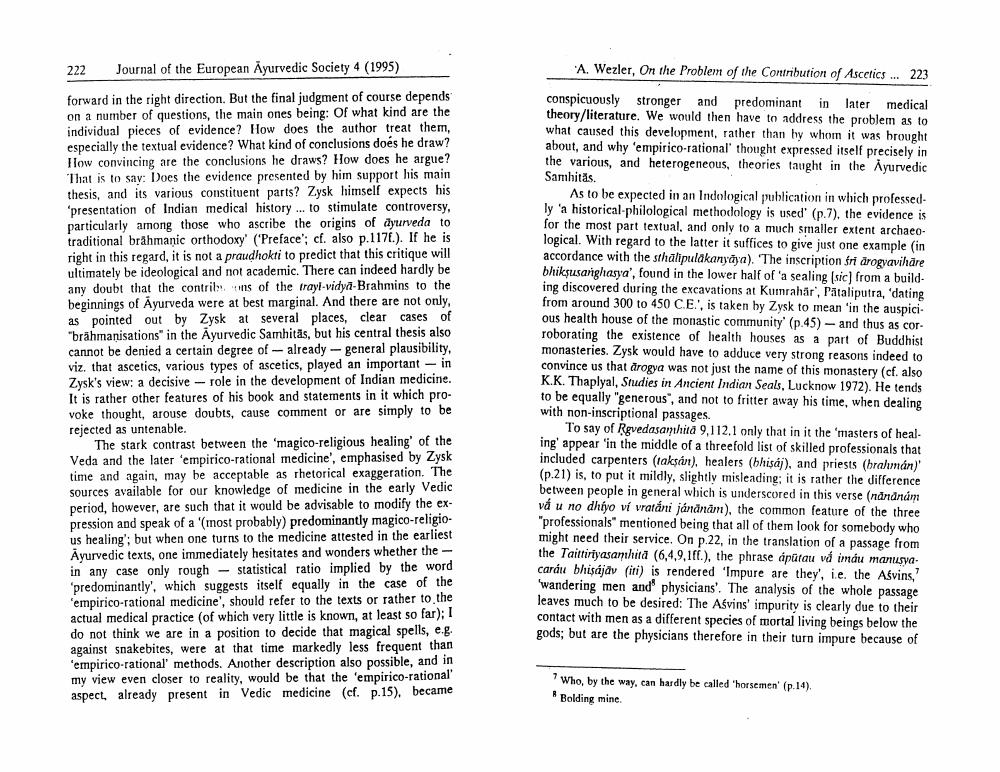________________
222
Journal of the European Ayurvedic Society 4 (1995)
A. Wezler, On the Problem of the Contribution of Ascetics ... 223
forward in the right direction. But the final judgment of course depends on a number of questions, the main ones being: Of what kind are the individual pieces of evidence? How does the author treat them, especially the textual evidence? What kind of conclusions does he draw? How convincing are the conclusions he draws? How does he argue? That is to say: Does the evidence presented by him support his main thesis, and its various constituent parts? Zysk himself expects his "presentation of Indian medical history ... to stimulate controversy, particularly among those who ascribe the origins of dyurveda to traditional brahmanic orthodoxy' ('Preface': cf. also p.1170.). If he is right in this regard, it is not a praudhokti to predict that this critique will ultimately be ideological and not academic. There can indeed hardly be any doubt that the contribuis of the trayl-vidy-Brahmins to the beginnings of Ayurveda were at best marginal. And there are not only, as pointed out by Zysk at several places, clear cases of "brahmanisations in the Ayurvedic Samhitas, but his central thesis also cannot be denied a certain degree of already - general plausibility, viz. that ascetics, various types of ascetics, played an important in Zysk's view; a decisive - role in the development of Indian medicine. It is rather other features of his book and statements in it which provoke thought, arouse doubts, cause comment or are simply to be rejected as untenable.
The stark contrast between the 'magico-religious healing' of the Veda and the later empirico-rational medicine', emphasised by Zysk time and again, may be acceptable as thetorical exaggeration. The sources available for our knowledge of medicine in the early Vedic period, however, are such that it would be advisable to modify the expression and speak of a '(most probably) predominantly magico-religious healing': but when one turns to the medicine attested in the earliest Ayurvedic texts, one immediately hesitates and wonders whether the in any case only rough - Statistical ratio implied by the word 'predominantly', which suggests itself equally in the case of the 'empirico-rational medicine, should refer to the texts or rather to the actual medical practice (of which very little is known, at least so far); do not think we are in a position to decide that magical spells, e.g. against snakebites, were at that time markedly less frequent than 'empirico-rational methods. Another description also possible, and in my view even closer to reality, would be that the 'empirico-rational aspect, already present in Vedic medicine (cf. p.15). became
conspicuously stronger and predominant in later medical theory/literature. We would then have to address the problem as to what caused this development, rather than by whom it was brought about, and why 'empirico-rational thought expressed itself precisely in the various, and heterogeneous, theories taught in the Ayurvedic Samhitas.
As to be expected in an Indological publication in which professedly 'a historical philological methodology is used' (p.7), the evidence is for the most part textual, and only to a much smaller extent archaeological. With regard to the latter it suffices to give just one example (in accordance with the sthalipulakanyaya). The inscription fri arogyavihäre bhiksusarghasya', found in the lower half of 'a sealing (sic) from a building discovered during the excavations at Kumrahar, Pataliputra, 'dating from around 300 to 450 C.E.', is taken by Zysk to mean 'in the auspicious health house of the monastic community' (p.45) - and thus as corroborating the existence of health houses as a part of Buddhist monasteries. Zysk would have to adduce very strong reasons indeed to convince us that arogya was not just the name of this monastery (cf. also K.K. Thaplyal, Studies in Ancient Indian Seals, Lucknow 1972). He tends to be equally "generous, and not to fritter away his time, when dealing with non-inscriptional passages.
To say of Rgvedasamthita 9.112.1 only that in it the 'masters of healing' appear in the middle of a threefold list of skilled professionals that included carpenters (taksán), healers (bhisáj), and priests (brahman)' (p.21) is, to put it mildly, slightly misleading; it is rather the difference between people in general which is underscored in this verse (ndndnám vá u no dhiyo vi vrarni jánānām), the common feature of the three "professionals" mentioned being that all of them look for somebody who might need their service. On p.22, in the translation of a passage from the Taittiriyasanhita (6,4,9,1ff.), the phrase ápūtau va imáu mam syacardu bhisájdy (ii) is rendered 'Impure are they', i.e. the Asvins, 'wandering men and physicians'. The analysis of the whole passage leaves much to be desired: The Asvins' impurity is clearly due to their contact with men as a different species of mortal living beings below the gods; but are the physicians therefore in their turn impure because of
Who, by the way, can hardly be called 'horsemen' (p.14). Bolding mine.




